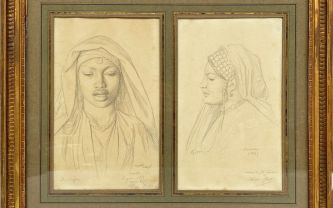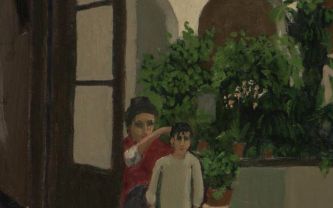Pierre-Antoine Martenet
Pierre-Antoine Martenet expertise des tableaux anciens depuis des années. Pour Auctie's, il est chargé de les expertiser et de les valoriser dans nos ventes à l'hôtel Drouot.


Maître de la scène naturelle et source d'inspiration pour les impressionnistes, Jean-François Millet (1814-1875) a apporté un renouveau au genre paysagiste traditionnel. En tant que théoricien, cet artiste à réussit à se libérer des enseignements de l'École des Beaux-Arts afin de peindre la nature de manière plus authentique.
Si vous détenez une œuvre réalisée par l’artiste Jean-François Millet ou d’après son travail et que vous souhaitez connaître sa valeur, nos experts et commissaires-priseurs agréés par l’État vous aiguilleront.
Nos spécialistes réaliseront une expertise gratuite de votre œuvre, et vous transmettront une estimation précise de sa valeur sur le marché actuel. Par la suite, si vous désirez vendre votre œuvre, nous vous orienterons vers le meilleur dispositif possible pour en obtenir un prix optimal.
Pierre-Antoine Martenet expertise des tableaux anciens depuis des années. Pour Auctie's, il est chargé de les expertiser et de les valoriser dans nos ventes à l'hôtel Drouot.

Jean-François Millet a réalisé diverses œuvres, notamment des peintures, des aquarelles et des estampes. Il a principalement représenté des paysages de voyage, des portraits et des scènes de genre.
Ses paysages naturalistes sont particulièrement recherchés aux enchères et peuvent atteindre plusieurs centaines de millions d’euros d’adjudication. En témoigne son huile sur toile La Cardeuse, adjugée plus de 2 millions d’euros chez Christie’s, tandis qu’elle était estimée entre 1 200 000 et 1 600 000€.
Technique utilisée | Résultat |
|---|---|
Estampe - multiple | De 10 à 19 200 € |
Dessin - aquarelle | De 20 à 1 302 500 € |
Peinture | De 400 à 2 454 000 € |


Jean-François Millet, figure incontournable du réalisme français, est reconnu pour ses représentations puissantes et émouvantes de la vie paysanne. Inspiré par son enfance rurale, Millet développe un style profondément ancré dans la réalité du monde agricole. Ses œuvres mettent en avant les travailleurs de la terre, et sa manière de capturer leur dignité dans l'effort physique en fait un peintre humaniste et proche du quotidien.
Millet excelle dans le traitement des figures humaines, qu’il représente dans des gestes simples, souvent en train de semer, labourer ou récolter. Il parvient à retranscrire la fatigue, la monotonie, mais aussi la force morale des paysans, tout en évitant l'idéalisation.
Son travail est imprégné de compassion pour les classes laborieuses, comme le montrent des œuvres célèbres telles que L'Angélus et Les Glaneuses. Ces tableaux emblématiques témoignent de son souci du détail et de sa quête de vérité sociale.
Sur le plan technique, Millet adopte un usage subtil de la lumière et de l'ombre, souvent tamisée pour accentuer le caractère humble et modeste des scènes qu'il peint. Sa palette, sobre et limitée, privilégie des tons terreux — ocres, bruns et verts — qui rappellent les paysages des champs et des prairies qu'il affectionnait.
Ce choix de couleurs naturelles reflète une proximité avec la terre, renforçant la dimension réaliste et spirituelle de ses œuvres.
Le dessin occupe une place importante dans sa pratique artistique. Millet utilise des lignes fortes et expressives pour structurer ses compositions, qu'il peaufine à l'aide de la craie noire, du fusain, ou du graphite. Ses études préparatoires, souvent précises et fouillées, révèlent sa maîtrise du dessin anatomique et des postures.
Millet atteint une maturité artistique dans les années 1850, où son style devient de plus en plus introspectif. Il se concentre sur des scènes intimes, des paysages pastoraux où l'homme et la nature coexistent harmonieusement.
Cette période marque aussi une recherche de simplicité et d'austérité, loin des fioritures académiques. Inspiré par ses propres souvenirs, il crée des œuvres poétiques et mélancoliques, laissant transparaître une certaine nostalgie de la ruralité perdue.
Ainsi, tout comme Corot, Millet s'attache à la réalité tout en insufflant une dimension spirituelle et universelle à ses œuvres. Ses compositions équilibrent la nature et l'humain dans une quête d'authenticité qui a marqué son époque, tout en influençant de nombreux artistes après lui, notamment ceux de l'école de Barbizon et les précurseurs de l'impressionnisme.
Jean-François Millet naît le 4 octobre 1814 à Gruchy, un petit hameau de la Manche, dans une famille de paysans. Dès son enfance, il est profondément influencé par la vie rurale, qui deviendra la source principale de son inspiration artistique. Son père, un homme pieux et lettré, encourage son intérêt pour le dessin.
En 1837, Millet part pour Cherbourg afin de recevoir une formation artistique sous la tutelle de Théophile Langlois, un ancien élève de David. Grâce à une bourse municipale, il est ensuite envoyé à Paris pour parfaire son apprentissage dans l'atelier de Paul Delaroche.
Ses débuts dans la capitale sont difficiles. Millet échoue plusieurs fois au concours du Prix de Rome et ne reçoit pas immédiatement la reconnaissance escomptée. Cependant, il persévère et, influencé par des maîtres tels que Nicolas Poussin et Eugène Delacroix, il commence à développer son propre style.
En 1849, après avoir rencontré des artistes comme Théodore Rousseau et Charles-François Daubigny, il rejoint l'École de Barbizon, un groupe de peintres paysagistes dont il devient une figure centrale. À Barbizon, Millet trouve un cadre idéal pour peindre la nature et les paysans qui l'habitent.
Millet se distingue par sa capacité à capter la vie quotidienne des travailleurs agricoles avec une profondeur émotionnelle rare. Ses œuvres, comme Les Glaneuses (1857) ou L'Angélus (1859), témoignent d'une grande humanité et sont souvent perçues comme des hommages à la dignité des paysans.
Contrairement aux artistes de son époque qui idéalisent la vie rurale, Millet représente ses sujets avec réalisme et sobriété, ce qui lui vaut des critiques de la part de la bourgeoisie parisienne, qui y voit parfois une critique sociale.
En 1867, bien que ses œuvres soient controversées, Millet reçoit enfin une reconnaissance officielle. Il est décoré de la Légion d'honneur lors de l'Exposition universelle de Paris. Pourtant, Millet continue de mener une vie modeste à Barbizon, loin des mondanités parisiennes.
La religion joue un rôle essentiel dans son existence, et son catholicisme profond transparaît dans ses tableaux, notamment dans la spiritualité silencieuse de scènes comme L'Angélus.
Ses dernières années sont marquées par la maladie, mais il continue de travailler jusqu'à sa mort, le 20 janvier 1875. L'année suivante, l'École des impressionnistes fait ses débuts, et Millet est salué comme une figure influente pour des artistes comme Vincent van Gogh, qui admire son travail pour sa représentation sincère de la vie paysanne.


Le tableau "L'Angélus" de Jean-François Millet incarne une dimension profonde et spirituelle dans l'univers rural du XIXe siècle. Dans cette œuvre, l'artiste fait preuve d'une maîtrise exceptionnelle du dessin, qui occupe une place centrale dans sa pratique artistique.
Les lignes rigoureuses et expressives qu'il utilise structurent cette composition. Il se sert de techniques comme la craie noire et le fusain, instruments qui lui permettent de donner vie à ses personnages tout en rendant palpable la pesanteur de leur condition paysanne.
Ses études préparatoires, détaillées et méticuleuses, révèlent son intérêt marqué pour la restitution fidèle des postures et des attitudes humaines.
Millet atteint sa maturité artistique dans les années 1850, une période où il affine son approche introspective et poétique. Il oriente alors son travail vers des scènes intimes et pastorales, où l'homme et la nature se répondent dans une harmonie silencieuse. L'Angélus en est un parfait exemple.
Le choix de représenter des paysans en pleine prière, arrêtant leur travail au son des cloches de l'église, témoigne de cette quête de simplicité et d'austérité.
Les deux figures, un homme et une femme, sont représentées dans une posture humble et recueillie, leurs visages tournés vers la terre, renforçant l'impression d'une communion entre l'humain et la nature.
Comme dans nombre de ses œuvres, Millet parvient à insuffler une dimension spirituelle à cette scène pourtant profondément ancrée dans la réalité quotidienne. La lumière du soir qui baigne la composition, associée à la ligne d'horizon basse, confère à l'œuvre un aspect presque mystique.
Le ciel vaste et sombre, caractéristique de cette recherche de sobriété, domine la scène et semble accentuer le caractère modeste et insignifiant des personnages face à l'immensité de la nature.
Millet, dans L'Angélus, montre aussi une certaine nostalgie pour un monde rural en train de disparaître, emporté par les bouleversements industriels de son temps. Son regard sur les paysans est empreint d'empathie, mais aussi d'une réflexion plus large sur la condition humaine.
À travers cette scène de prière, il ne se contente pas de peindre la vie paysanne ; il explore les rapports entre l'homme, le travail, et la spiritualité, dans une quête d'authenticité qui le distingue de ses contemporains.
Ce tableau, loin de s'en tenir à une simple représentation réaliste, porte en lui une portée universelle et intemporelle qui influencera profondément les générations suivantes, notamment les artistes de l'école de Barbizon et les premiers impressionnistes.
Dans les années 1850, Millet atteint une maturité artistique caractérisée par une introspection accrue. Ses œuvres se concentrent alors sur des scènes de la vie rurale, souvent dépouillées et empreintes de gravité.
Contrairement aux tendances académiques de l’époque, il rejette les fioritures et préfère la simplicité. Inspiré par ses souvenirs d’enfance en Normandie, il dépeint des paysans au travail, conférant à ces scènes une spiritualité latente.
Ses œuvres, telles que L’Angélus ou Les Glaneuses, sont empreintes d’une nostalgie et d’une quête d’authenticité. Loin d’idéaliser la ruralité, il en montre la dureté tout en soulignant sa dimension sacrée.
Cette période de maturité voit également Millet explorer la relation intime entre l’homme et la nature. Ses compositions équilibrent avec soin la figure humaine et le paysage, créant un dialogue entre les deux. Ses paysans, souvent représentés dans des moments de travail ou de prière, semblent fondus dans leur environnement, incarnant une harmonie silencieuse avec la terre qu’ils cultivent.
À travers ce traitement, Millet parvient à transcender la simple représentation réaliste et à offrir une vision poétique et universelle de la condition humaine.
L’empreinte laissée par Millet dépasse l’aspect technique. Il a influencé non seulement l'école de Barbizon, dont il est l'un des membres fondateurs, mais aussi les générations suivantes, notamment les impressionnistes.
Comme Corot, Millet s'attache à une réalité tangible, mais il insuffle à cette réalité une dimension spirituelle. Ses œuvres, en apparence simples, sont profondément imprégnées d’une recherche d’authenticité, une quête qui résonnera chez de nombreux artistes du XXe siècle, et qui fait de lui l’un des piliers de la peinture réaliste et paysagère de son époque.
Les œuvres de Jean-François Millet ne sont pas toutes signées.
Même s’il y existe des variantes, voici un premier exemple de sa signature :

Si vous êtes propriétaire d'une œuvre de Jean-François Millet, n'hésitez pas à solliciter une évaluation gratuite en remplissant notre formulaire en ligne. Un membre de notre équipe, composée d'experts et de commissaires-priseurs agréés, vous contactera pour vous fournir une estimation de la valeur marchande de votre œuvre.
Si vous envisagez de vendre votre œuvre, nos spécialistes vous guideront également à travers les différentes alternatives disponibles pour obtenir le meilleur prix possible, en tenant compte des tendances du marché et des spécificités de chaque œuvre.

Valeur et cote des oeuvres de Jean Léon Gérôme : peintures,...
Jean Léon Gérôme, peintre et sculpteur du XIXème siècle, est un des artistes du second Empire le plus renommé. La cote de ses oeuvres est haute.
En savoir plus >

Cote et valeur des oeuvres, tableaux de Jean-Joseph Benjamin...
Benjamin-Constant est un peintre orientaliste du XIXème. Auteur d'une production riche; ses oeuvres ont de la valeur et une cote haute aux enchères.
En savoir plus >

Cote et valeur 2024 des tableaux, peintures de Marius Borgea...
Marius Borgeaud est un peintre luministe du XIXème siècle qui a produit des tableaux dont la cote et la valeur sont en hausse aux enchères.
En savoir plus >
Site sécurisé, anonymat conservé
Commissaire-priseur et expert agréé par l'État
Estimations gratuites et certifiées